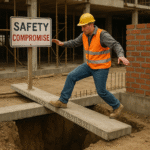|
Getting your Trinity Audio player ready...
|
How one construction manager’s fatherly approach became a workplace harassment complaint – and what it teaches us about intent versus impact in Australia’s building industry
You’re a construction manager working on a remote site with a young female worker. She’s new to the industry, eager to learn, and you want to help her succeed. You treat her like you would your own daughter – offering extra guidance, checking in frequently, and making sure she feels supported. You’re being kind, right?
You may be wrong.
What you think is mentorship might actually be creating an uncomfortable, potentially harassing work environment. And this scenario plays out across construction sites throughout Australia more often than most of us realize.
Amy O’Connor, an HR professional with 27 years of experience in construction, recently shared a case study that perfectly illustrates why good intentions aren’t enough to prevent workplace harassment. Her story reveals the complex dynamics that construction leaders must understand to create truly respectful workplaces where everyone can thrive safely.
When Fatherly Becomes Uncomfortable: The Real Case Study
Amy’s case involved a hardworking construction manager and a young woman working together on a remote site. The manager, with genuinely good intentions, began treating his female colleague the way he would treat his own daughter. He offered constant guidance, checked on her welfare regularly, and took what he considered a protective stance toward her work and well-being.
The problem? This young woman wasn’t his daughter. She was a professional colleague trying to establish herself in the construction industry. What felt supportive to him felt invasive and inappropriate to her. The situation escalated when they were required to travel together in vehicles to various sites. The confined space amplified the discomfort, turning well-intentioned mentorship into what became a formal harassment complaint.
This scenario highlights a critical gap in understanding that affects construction sites across Australia. The manager’s intent was positive, but the impact on his colleague was negative. In construction culture, where mateship and looking out for each other are valued, this distinction between intent and impact becomes particularly crucial to address.
The young woman eventually came forward to report her discomfort, but not before enduring weeks of feeling uncomfortable at work. She hadn’t developed the skills or confidence to speak up earlier, and the manager remained completely unaware that his behaviour was causing distress. Both parties were operating with different expectations and understanding of appropriate workplace interactions.
The Intent Versus Impact Problem in Construction
Australian construction sites have traditionally operated under an informal, mateship-based culture where looking out for your colleagues is considered essential. This cultural foundation creates unique challenges when it comes to understanding appropriate workplace behaviour. Many construction workers, particularly those with decades of experience, struggle to recognize when their well-intentioned actions cross professional boundaries.
The intent versus impact issue is particularly complex in construction because the industry’s traditional masculine culture often emphasizes protection and guidance. Experienced workers genuinely want to help newcomers succeed, especially when those newcomers are women entering a male-dominated environment. However, this protective instinct can quickly become problematic when it’s not balanced with respect for professional boundaries and individual autonomy.
Amy’s case study demonstrates how environmental factors amplify inappropriate behaviour. What might have been manageable in an office setting became deeply uncomfortable in the confined space of a work vehicle. Construction work often involves close quarters, remote locations, and extended time periods, working closely together. These factors mean that even small boundary violations can quickly escalate into significant problems.
The situation also reveals how generational and cultural differences affect workplace dynamics. The manager’s approach might have been appropriate in previous decades or in different cultural contexts, but today’s construction workforce operates under different expectations. Young workers entering the industry expect professional boundaries and respectful treatment, regardless of gender. They’re not looking for parental figures; they’re seeking mentors who can guide their professional development while respecting their autonomy.
Construction leaders must understand that impact trumps intent when it comes to harassment prevention. Even the most well-meaning behaviour can create hostile work environments if it makes colleagues uncomfortable. This reality requires a fundamental shift in how we approach workplace relationships in construction, moving from intuitive, relationship-based interactions to more structured, professional approaches that respect individual boundaries.
The Hidden Costs of Uncomfortable Workplaces
When workplace interactions make people uncomfortable, the costs extend far beyond individual discomfort. In Amy’s case study, the young woman endured weeks of distress before finding the courage to speak up. During this time, her productivity, mental health, and job satisfaction were all negatively affected. She was spending energy managing her discomfort rather than focusing on developing her construction skills and contributing to project success.
The construction industry is already facing a significant skills shortage, with women representing only 12% of the construction workforce according to Australian Bureau of Statistics data. When women enter the industry but then encounter uncomfortable workplace dynamics, they’re far more likely to leave before completing their training or establishing long-term careers. This creates a cycle where the industry continues struggling with diversity and skills shortages.
For companies, uncomfortable workplace dynamics lead to increased turnover, reduced productivity, and potential legal liability. The formal complaint process requires HR resources, management time, and often results in restructuring work arrangements. In Amy’s case, the two workers had to be separated, creating additional logistical challenges for project management. These costs are entirely preventable through proactive boundary awareness and respectful workplace practices.
The reputational risks are equally significant. Construction companies increasingly compete for talent in a tight labour market. Word spreads quickly in construction communities about companies where workers feel uncomfortable or unwelcome. Young professionals entering the industry actively research company cultures and seek out employers known for respectful workplace environments. Companies that fail to address boundary issues find themselves at a competitive disadvantage in talent acquisition.
Mental health impacts affect both parties in these situations. The young woman experienced stress and anxiety about coming to work, while the manager later felt confused and defensive when his well-intentioned actions were challenged. Neither party benefited from the situation, and both required support to move forward constructively. These human costs highlight why prevention through clear expectations and boundary awareness is so much more effective than reactive responses to complaints.
Workplace Harassment: Environmental Factors That Amplify Problems
Construction work presents unique environmental challenges that can turn minor boundary issues into major problems. Amy’s case study perfectly illustrates how the confined space of a work vehicle transformed uncomfortable interactions into a harassment complaint. Construction leaders must understand these environmental amplifiers to prevent similar situations.
Remote construction sites create isolation that intensifies workplace dynamics. When workers are far from supervision, company policies, or support systems, inappropriate behaviour can escalate quickly. The informal nature of remote work environments often breaks down professional boundaries that would naturally exist in more structured office settings. Workers may feel like normal social rules don’t apply, leading to increasingly casual interactions that cross professional lines.
Extended work periods common in construction projects create familiarity that can be misinterpreted. When workers spend long hours together, often in challenging conditions, natural bonding occurs. However, this workplace intimacy must be balanced with professional respect. The manager in Amy’s case likely felt that their extended time working together justified more personal interactions, but this assumption created discomfort for their colleague.
Physical proximity requirements in construction work add another layer of complexity. Workers often need to coordinate closely, share tools and equipment, and navigate tight spaces together. These necessary physical interactions require heightened awareness of personal boundaries and consent. What feels comfortable to one person may feel invasive to another, particularly when gender dynamics are involved.
The hierarchical nature of construction work creates power imbalances that affect how behaviour is received. When a senior manager offers guidance or assistance, junior workers may feel pressured to accept even when they’re uncomfortable. This power dynamic means that senior workers bear additional responsibility for maintaining appropriate boundaries and checking in about comfort levels rather than assuming acceptance.
Construction’s traditionally masculine culture often emphasizes directness and informality, which can mask boundary violations. Behaviour that seems normal within established construction culture may feel intimidating or inappropriate to newer workers, particularly women. This cultural gap requires active bridge-building through clear communication and ongoing boundary awareness rather than assumptions about shared comfort levels.
Reading the Signs: Body Language and Comfort Cues
One of the most valuable lessons from Amy’s case study is the importance of reading comfort cues and responding appropriately when someone’s body language changes. The manager in this situation missed several opportunities to recognize that his colleague was becoming uncomfortable and adjust his approach accordingly.
Body language changes are often the first indicator that workplace interactions are crossing boundaries. When someone becomes quieter, starts avoiding eye contact, or physically distances themselves, these are clear signals that something has shifted. In construction environments where direct communication is valued, learning to read these non-verbal cues becomes especially important for preventing escalation of uncomfortable situations.
Amy emphasizes the power of simple check-ins when you notice body language changes. Questions like “I noticed you reacted to that – did something I say offend you?” or “I want to make sure you’re comfortable with how we’re working together” can prevent minor discomfort from becoming major complaints. These conversations require courage and emotional intelligence, but they demonstrate respect for colleagues and commitment to maintaining professional relationships.
Environmental awareness plays a crucial role in reading comfort cues accurately. The confined space of the work vehicle in Amy’s case study likely amplified discomfort signals that might have been more subtle in an open office environment. Construction workers must develop heightened sensitivity to how environmental factors affect their colleagues’ comfort levels and adjust their behaviour accordingly.
Creating opportunities for private feedback helps colleagues express discomfort safely. Many workers, particularly those new to the industry, lack the confidence to directly address boundary issues with senior colleagues. Establishing regular check-ins, anonymous feedback systems, or clear escalation pathways gives people safe ways to raise concerns before they become formal complaints.
The key is developing self-awareness about how your behaviour affects others and being willing to adjust based on feedback. Amy’s case study shows that even well-intentioned managers can create uncomfortable situations when they fail to monitor their colleagues’ comfort levels. Regular self-reflection and proactive communication prevent these situations from escalating.
READ ALSO: The Seven-Year Price of One Bad Decision: A Construction Worker’s Injury Story
The Power of Clear Communication and Boundaries

Amy’s experience highlights how clear communication and established boundaries could have prevented the harassment complaint entirely. Both parties in her case study lacked the tools and frameworks for discussing comfort levels and professional expectations, leading to weeks of accumulated discomfort before formal intervention became necessary.
Professional boundary setting starts with clear expectations about workplace relationships and appropriate interactions. Construction companies need explicit policies and training about what constitutes appropriate mentoring, guidance, and support versus inappropriate personal involvement. These guidelines should address the unique challenges of construction environments, including remote sites, extended work periods, and close physical proximity requirements.
Simple communication techniques can prevent most boundary violations before they escalate. Amy suggests straightforward approaches like asking “Do you mind if I call you mate?” or “Are you comfortable with this arrangement?” These questions acknowledge that comfort levels vary between individuals and demonstrate respect for personal preferences. They also create opportunities for colleagues to express preferences before discomfort develops.
Regular check-ins about working relationships help maintain appropriate boundaries over time. Rather than assuming that initial comfort levels remain constant, construction leaders should periodically assess whether working arrangements are still appropriate for everyone involved. This is particularly important in evolving situations like mentoring relationships or project partnerships that extend over time.
Creating clear escalation pathways ensures that discomfort can be addressed quickly before formal complaints become necessary. Workers should know who to contact when they feel uncomfortable, what support is available, and how concerns will be handled confidentially. This infrastructure prevents situations like Amy’s case study, where the young woman endured weeks of discomfort because she didn’t know how to address the issue effectively.
Training programs should include practical scenarios and role-playing exercises that help construction workers practice appropriate boundary-setting conversations. Many workers have good intentions but lack the communication skills to manage sensitive conversations effectively. Providing concrete examples and practice opportunities builds confidence and competence in maintaining professional relationships.
Real Solutions That Actually Work
Based on Amy’s extensive experience and the lessons from her case study, construction leaders can implement several practical strategies to prevent intent-versus-impact problems while maintaining supportive workplace cultures.
First, establish clear mentoring and guidance protocols that respect professional boundaries while still supporting worker development. These protocols should specify appropriate ways to offer help, check on welfare, and provide guidance without crossing into personal territory. For example, mentoring conversations should focus on skill development, career goals, and professional challenges rather than personal life or family-style relationships.
Implement environmental awareness training that helps workers understand how different settings affect comfort levels. The vehicle scenario in Amy’s case study could have been prevented if both parties had understood how confined spaces amplify interpersonal dynamics. Training should cover strategies for maintaining professionalism in vehicles, remote sites, and other challenging construction environments.
Create structured feedback systems that allow workers to express comfort levels safely and regularly. This might include anonymous surveys, regular one-on-one meetings with supervisors, or peer support programs where workers can discuss concerns with trusted colleagues. The key is providing multiple pathways for feedback so that issues can be addressed before they escalate.
Develop situation-specific guidelines for common construction scenarios that create boundary challenges. This includes protocols for mentoring relationships, travel arrangements, remote site work, and extended project partnerships. Clear guidelines remove guesswork and provide frameworks for maintaining appropriate relationships in challenging environments.
Invest in communication skills training for all levels of construction workers, with particular emphasis on reading comfort cues, asking appropriate questions, and responding constructively to feedback. Many construction workers have technical expertise but lack the interpersonal skills needed for today’s diverse workforce. Communication training should be practical, scenario-based, and specifically tailored to construction industry challenges.
Building Self-Awareness in Construction Leadership
Amy’s case study reveals that self-awareness is perhaps the most critical skill for preventing intent-versus-impact problems in construction workplaces. The manager involved had good intentions but lacked awareness of how his behaviour was affecting his colleague. This awareness gap is common in construction leadership and requires targeted development.
Self-reflection practices help construction leaders understand their own communication styles and how they might be received by different colleagues. This includes examining assumptions about appropriate behaviour, understanding how personal background influences interactions, and developing sensitivity to how others might interpret actions differently. Regular self-reflection prevents leaders from operating on autopilot in their workplace relationships.
Feedback-seeking behaviours demonstrate commitment to respectful workplace relationships and help leaders identify blind spots in their interpersonal interactions. Construction leaders should actively ask colleagues about their comfort levels, request input on communication styles, and remain open to adjusting their approach based on feedback. This proactive approach prevents problems like those in Amy’s case study.
Understanding power dynamics is essential for construction leaders who want to maintain appropriate relationships with team members. Senior workers hold inherent authority that affects how their behaviour is received, regardless of their intentions. Leaders must acknowledge this power differential and take additional responsibility for maintaining appropriate boundaries and ensuring that junior workers feel safe expressing discomfort.
Developing empathy skills helps construction leaders understand how their behaviour might feel from their colleagues’ perspectives. This includes considering how gender, age, experience level, and cultural background affect workplace interactions. The manager in Amy’s case study might have avoided problems by considering how his fatherly approach might feel to a young professional woman trying to establish credibility in the industry.
Continuous learning about appropriate workplace behaviour keeps construction leaders updated on evolving expectations and best practices. What was considered acceptable behaviour in construction decades ago may not be appropriate today. Leaders should stay informed about harassment prevention, respectful workplace practices, and inclusive leadership approaches through ongoing training and professional development.
RELATED TOPIC: Mental Health: The Silent Crisis on Australian Construction Sites
Creating Safe Spaces for Difficult Conversations
One of the most valuable aspects of Amy’s approach to resolving the harassment complaint was creating space for both parties to understand each other’s perspectives and learn from the situation. This approach offers a model for how construction companies can address boundary issues constructively while maintaining workplace relationships and preventing future problems.
Safe conversation spaces require skilled facilitation and clear ground rules that prioritize understanding over blame or punishment. Both parties in Amy’s case study needed to express their perspectives, understand the impact of their actions, and develop strategies for future interactions. This requires neutral facilitation and commitment from both parties to approach the conversation with openness and a learning mindset.
Focusing on impact rather than intent helps parties understand why behaviour was problematic without demonizing well-meaning individuals. The manager in Amy’s case study needed to understand that his good intentions didn’t eliminate the negative impact of his behaviour. Similarly, the young woman needed to understand that she could address discomfort directly without assuming malicious intent from her colleague.
Learning-oriented conversations prevent similar problems in the future by building awareness and skills rather than simply addressing the immediate complaint. Amy’s approach helped both parties develop tools for future workplace relationships, including boundary-setting skills for the young woman and awareness skills for the manager. This investment in learning creates long-term benefits that extend beyond the immediate situation.
Follow-up support ensures that lessons learned in difficult conversations translate into sustained behaviour change. Amy’s case study included ongoing support for both parties as they rebuilt their working relationship and applied their new understanding to future interactions. This follow-up prevents recurrence and demonstrates organizational commitment to respectful workplace relationships.
Documentation and policy development help organizations learn from specific incidents and prevent similar problems across the workforce. Amy’s experience informed broader training programs and policy development that benefited other workers facing similar challenges. This systematic approach maximizes the learning value of difficult situations and creates organizational resilience against future boundary issues.
The Economic Case for Respectful Workplaces
While the human costs of uncomfortable workplaces are compelling enough, construction companies also need to understand the economic implications of intent-versus-impact problems. Amy’s case study illustrates costs that extend far beyond the immediate complaint resolution process.
Productivity losses occur when workers spend mental and emotional energy managing uncomfortable workplace relationships instead of focusing on their construction work. The young woman in Amy’s case study was distracted and stressed for weeks before addressing her concerns, directly impacting her ability to contribute effectively to the project. These productivity losses multiply across teams when workplace culture issues affect multiple workers.
Turnover costs are particularly significant in construction, where skilled workers are in high demand and training investments are substantial. When workers leave due to uncomfortable workplace experiences, companies lose not only their immediate contributions but also their future potential and the training investments made in their development. Women and other underrepresented groups are especially likely to leave construction when they encounter boundary issues.
Recruitment challenges increase when companies develop reputations for uncomfortable workplace cultures. In today’s competitive construction labour market, skilled workers actively research potential employers and share experiences through professional networks. Companies known for boundary problems find it increasingly difficult to attract top talent, particularly from underrepresented groups that could help address skills shortages.
Legal and compliance costs can be substantial when intent-versus-impact issues escalate to formal complaints or legal action. While Amy’s case study was resolved internally, similar situations can result in significant legal expenses, regulatory penalties, and reputational damage. Prevention through proactive boundary awareness is far more cost-effective than reactive responses to formal complaints.
Lost opportunities for innovation and growth occur when companies fail to maintain diverse, inclusive workforces where all workers feel comfortable contributing their best ideas and efforts. Construction companies need diverse perspectives to address complex challenges and identify new opportunities. Workplace cultures that make any group uncomfortable limit access to the full range of talents and insights needed for competitive advantage.
Training Programs That Actually Work
Amy’s experience developing and delivering respectful workplace training provides insights into what makes construction industry training effective versus what approaches fail to create lasting change. Her success comes from understanding construction culture while challenging problematic aspects of traditional approaches.
Scenario-based training that addresses real construction situations helps workers understand how respectful workplace principles apply to their daily experiences. Generic harassment prevention training often fails in construction environments because it doesn’t address industry-specific challenges like remote sites, extended work periods, and physical proximity requirements. Effective training uses realistic scenarios that workers can relate to and apply immediately.
Interactive discussions rather than lecture-style presentations engage construction workers and allow them to share experiences and learn from each other. Amy’s training approach encourages participants to discuss boundary challenges they’ve encountered and develop practical solutions collaboratively. This peer learning approach is more effective than top-down instruction because it respects workers’ experience while building new skills.
Focusing on positive behaviour rather than just prohibition helps construction workers understand what respectful workplace relationships look like in practice. Rather than simply listing inappropriate behaviours, effective training demonstrates professional mentoring, appropriate guidance, and respectful communication techniques. This positive approach gives workers concrete alternatives to problematic traditional approaches.
Leadership modelling and accountability ensure that training messages are reinforced through daily workplace practices. When construction leaders demonstrate respectful boundary-setting and communication skills, it reinforces training content and creates cultural change. Without leadership commitment, training programs become empty exercises that fail to create lasting improvement.
Regular refresher training and ongoing skill development prevent backsliding and help workers apply lessons to new situations. One-time training sessions are insufficient for creating lasting culture change. Effective programs include ongoing support, skill development opportunities, and regular reinforcement of respectful workplace principles through daily practice and feedback.
Moving Forward: Next Steps for Construction Leaders
Amy’s case study and her broader experience in construction HR provide a roadmap for leaders who want to prevent intent-versus-impact problems while maintaining supportive workplace cultures. The key is taking proactive steps rather than waiting for complaints to emerge.
Immediate actions include reviewing current mentoring and guidance practices to identify potential boundary issues before they become problems. Construction leaders should examine their own workplace relationships and ask whether their approaches might make colleagues uncomfortable. This self-assessment should include consideration of power dynamics, environmental factors, and individual comfort levels.
Policy development should address construction-specific scenarios while establishing clear expectations for appropriate workplace relationships. Generic policies often fail to provide guidance for construction industry challenges. Effective policies should cover remote site work, vehicle travel, mentoring relationships, and other situations where boundary issues commonly arise.
Training implementation should be practical, scenario-based, and ongoing rather than one-time compliance exercises. Construction workers need opportunities to practice respectful communication skills, discuss boundary challenges, and learn from experienced colleagues who model appropriate behaviour. This training should be integrated into regular professional development rather than treated as separate harassment prevention.
Cultural change initiatives should celebrate respectful workplace relationships while challenging problematic traditional approaches. Construction culture has many positive aspects that should be preserved, including mateship, mutual support, and commitment to safety. The goal is evolving these positive cultural elements while eliminating aspects that create discomfort or exclusion for any workers.
Measurement and continuous improvement help construction companies track progress and identify areas needing additional attention. This includes regular surveys about workplace culture, analysis of complaint patterns, and monitoring of retention rates across different demographic groups. Data-driven approaches ensure that improvement efforts are effective and address the most significant challenges.
Final Take
Construction culture is evolving, and with it comes the responsibility for all of us to understand that our intentions, however good, must be balanced with awareness of how our actions affect our colleagues. Amy’s case study reminds us that creating respectful workplaces requires ongoing effort, clear communication, and a willingness to learn from each other’s experiences. When we get this balance right, everyone benefits – workers feel valued and respected, productivity improves, and the construction industry becomes a place where all talented individuals can build successful careers.
The path forward isn’t about eliminating the supportive, mateship-based culture that makes construction special. It’s about evolving that culture to ensure everyone feels included and respected. That evolution starts with each of us taking responsibility for understanding how our behaviour affects others and being willing to adjust when needed. As Amy’s experience shows, these conversations might be uncomfortable initially, but they create workplaces where everyone can focus on building great things together.







